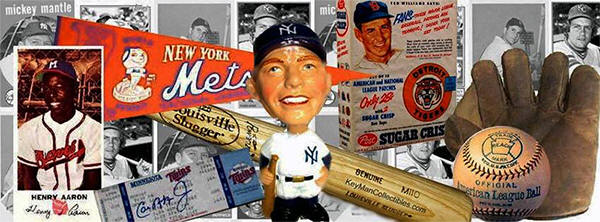|
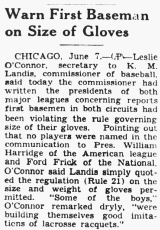 |
July 7, 1939
Newspaper Clipping |
|
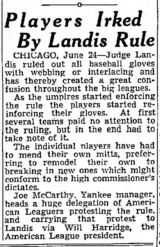 |
July 24, 1939
Newspaper Clipping |
|
 |
|
July
13, 1943 Latina Trapper Patent |
|
|
|
|
|
|
|
| Keymancollectibles.com |
The
Webs Best Recourse for Baseball Memorabilia |
July 20,
2017 |
|
|
|
|
|
Hank
Greenberg's
Fishnet
First
Baseman's
Mitt
- Rule
21 and
The Trapper
Model |
|
|
|
|
|
|
|
The
development
of the
"Trapper"
begins
with
Hank
Greenberg,
first
baseman
of the
Detroit
Tigers.
In 1938
there
were no
rules
about
the
type or
size of
a first
baseman's
mitt.
Rule 21
states:
"The
catcher
or
firstbaseman
may
wear a
leather
glove
or mitt
of any
size,
shape
or
weight.
Every
other
player
is
restricted
to the
use of
a
leather
glove
 weighing
not
more
than 10
ounces
and
measuring
not
over 14
inches
around
the
palm.
The
pitcher's
glove
must be
uniform
in
color." weighing
not
more
than 10
ounces
and
measuring
not
over 14
inches
around
the
palm.
The
pitcher's
glove
must be
uniform
in
color."
Hank Greenberg concocted a mitt that looked as big as a catchers mitt with
a
fishing
net
attached.
In 1939
Greenberg's
oversized
mitt
was the
source
of
worry,
and
protest.
A local
sports
writer
wrote
in jest
that
the
mitt
was "Ready
for
anything.
This
mitt is
a
triumph
of
modern
science.
It
Contains:
1.
Three
lengths
of
barbed
wire.
2.
Four
corners,
and two
side
pockets
as on a
pool
table.
3.
A
fishnet,
rod and
reel,
hoe,
shovel,
and
trowel.
4.
A small
but
select
library
of
standard
classics.
5.
A
compact
anti-aircraft
gun to
bring
down
high
throws.
6.
A
change
of
clothes,
and a
pocket
comb,
for
Hank is
a
dapper
fellow
who
likes
to be
prepared
for
emergencies."
Greenberg's mitt was no worse than others except it might have been a
little
bit
larger
than
some.
The
first
basemen
were
not the
only
offenders.
Nearly
every
fielder
in
baseball
had
doctored
his
glove
to some
extent
and the
regulations
were
vague.
June of
1939,
Judge
Kenesaw
M.
Landis
investigated
the
matter.
In
general
players
did not
take it
serious.
Hank
would
not
give up
his
glove
to an
umpire
unless
they
promised
to let
him use
a peach
basket
in its
place.
After
being
notified
by the
office
of
Judge
Landis
that
his
glove
would
be
taken
away,
Greenberg
changed
his
defensive
tactics.
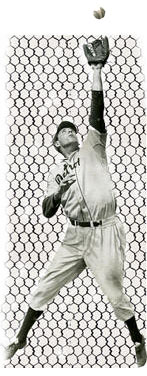
What Hank planned to do was build a three-sided fence back and around
first
base,
with
wire
hen-coop
netting
stretched
above
it to
take
care of
the
higher
throws
from
infielders
Pinky
Higgins,
and
Billy Rogell.
The
ground
within
the
stockade
would
be
funneled
out so
that
the
ball
hitting
against
any
part of
the
fence,
would
automatically
roll
into
the
center
of the
pit,
where
Hank
could
pick it
up and
touch
the bag
at his
leisure.
When
word
reached
Greenberg
from
the
Landis
office
that
the
fences
were
out.
Hank
replied
"But if
you
take my
glove
away
what is
to
become
of my
iron
defense?
Do you
want me
to use
flypaper?
Joe McCarthy, manager of the Yankees when he had nothing else to beef
about,
used to
beef
about
Greenberg's
mitt.
"What
have
you got
there a
butterfly
net?"
McCarthy
would
snarl
at
Greenberg,
pointing
to the
glove.
Hank
with
his
feelings
hurt,
would
reach
into
the
mitt,
pull
out a
good
book
and
begin
to
browse
through
it,
ignoring
McCarthy,
while
Joe and
the
umps
went at
it. It
was
good
clean
fun,
until
the day
the
Landis
office
decided
to
attack
the
glove
problem
and
clean
up the
glove
situation.
Rule 21 was rewritten at the time the protest was made about the mitt Hank
Greenberg
was
using
and was
inserted
into
the
rulebook
that
year.
Presidents
in both
leagues
were
informed
that
the
players
should
be
warned
that
the
rule
would
be
strictly
enforced
by all
umpires
within
a few
days of
the
receipt
of the
notice.
|
|
|
|
 |
|
|
|
Landis
did not
want
the
gloves
to
resemble
a birds
nest or
a
"lacrosse
racquet."
Interlocking
fishnet
type
webbing
was
out.
The
lacing
must go
straight
across
from
thumb
to
index
finger
and may
not be
crossed.
First
basemen
contend
that
single
lacing
permitted
for
them
under
the new
rules
was not
sufficient,
but
Judge
Landis
made
the
players
conform
to the
rule
whether
they
liked
it or
not.
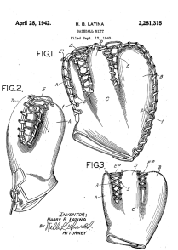
It was a fortuitous time for Rawlings glove designer Harry B. Latina. By
1940 he
revolutionized
the
base
mitt
with
his
"Trapper"
design,
replacing
the
older
"Oven
Mitt"
style.
In 1940
Rawlings
and
Latina
filed
for a
patent
that
was
granted
in
1942.
The
main
object
of
Latina's
invention
was to
provide
a
baseball
mitt,
which
is of
such
design
or
construction
that
when it
is
subjected
to the
pressure
of a
caught
ball,
will
automatically
close
around
the
ball,
effectively
"Trap"
it. A
design
that
also
complies
with
the
rules,
regulations
and
requirements
pertaining
to such
devices,
and
which
has a
ball
back-stop
that is
more
efficient
than
those
employed
in
mitts
of
conventional
design.
The
"Trapper
model"
is
born.
The glove was a hit with players however there was concern that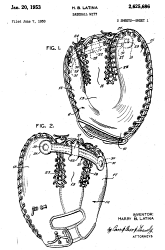 the lacing
could
be
loosened
up to
make
the web
bigger
than
the
dimensions
in the
rule
book
for a
legal
glove.
In 1950
modifications
were
made
and a
patent
was
applied
for to
place a
"web
controller"
strap
at the
top of
the
web.
That
way, no
matter
how
much
you
loosened
up the
laces,
the web
could
only
get as
wide as
the web
controller,
maintaining
the
legal
distance
between
the
thumb
and
forefinger.
The
patent
was
granted
in
1953. the lacing
could
be
loosened
up to
make
the web
bigger
than
the
dimensions
in the
rule
book
for a
legal
glove.
In 1950
modifications
were
made
and a
patent
was
applied
for to
place a
"web
controller"
strap
at the
top of
the
web.
That
way, no
matter
how
much
you
loosened
up the
laces,
the web
could
only
get as
wide as
the web
controller,
maintaining
the
legal
distance
between
the
thumb
and
forefinger.
The
patent
was
granted
in
1953.
The Trapper Model featured a well balanced design that permits the mitt to
break
as much
on the
little
finger
side as
the
thumb
side,
causing
both
sides
of the
mitt to
close
over
the
ball,
when
the
ball
hits
the
center
panel,
and
forms a
positive
trap.
The
Trapper
model
was
picked
up by
all the
major
manufactures.
Most
came
with
instructions
on how
to wear
the
mitt.
The
center
panel
of the
web
warned:
"DO NOT
PUT
FINGERS
IN THIS
SECTION"
The
thumb
was
inserted
in its
usual
place,
and on
the
pinky
side of
the
glove
read
"PLACE
ALL
FINGERS
IN THIS
SECTION
WITH
SMALL &
THIRD
FINGERS
THRU
ADJUSTIBLE
LOOP" |
|
|
|
|
|
|
|
KEYMAN
COLLECTIBLES
RELATED
RESOURCES |
|
|
|
|
|
|
|
|
|
|
|
|
|
|
|
Back To
KeyMan
Collectibles
Collectors
Corner |
|
|
|

